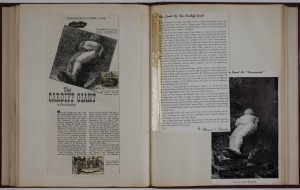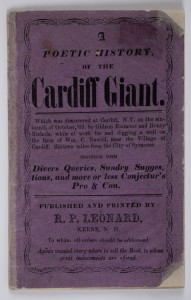In 1869, a giant was uncovered, and along with it, a giant hoax. The 10 foot statue of what was thought to be a petrified man was unearthed at a farm in Cardiff, NY. The Cardiff Giant, as it quickly became known, confounded scientists, historians, and the general population. Was this a statue made to honor giants that used to walk the earth? Was it the fossilized remains of one of the said giants? Many theories were discussed, but it didn’t take long for suspicion to arise. The hoax was soon discovered.
 George Hull of Binghamton, NY, buried the statue on a friend’s farm in Cardiff after having a frustrating debate with a preacher about the presence of Giants on earth – Hull disagreed with the preacher’s too literal reading of the Bible. In probably one of the most extravagant practical jokes ever, Hull decided to find an over 10 foot piece of gypsum, have an artist carve the slab into a statue, and cart it all the way to Cardiff for a proper burial – not an easy feat for 1868! However, hoax or not, people were still interested. People still wanted to see the Giant, not only because some might have thought it the real thing, but because of the controversy it was stirring. Hull made a fortune charging people to view the statue, as well as exhibiting it across the state.
George Hull of Binghamton, NY, buried the statue on a friend’s farm in Cardiff after having a frustrating debate with a preacher about the presence of Giants on earth – Hull disagreed with the preacher’s too literal reading of the Bible. In probably one of the most extravagant practical jokes ever, Hull decided to find an over 10 foot piece of gypsum, have an artist carve the slab into a statue, and cart it all the way to Cardiff for a proper burial – not an easy feat for 1868! However, hoax or not, people were still interested. People still wanted to see the Giant, not only because some might have thought it the real thing, but because of the controversy it was stirring. Hull made a fortune charging people to view the statue, as well as exhibiting it across the state.
Many people over the years made offers to buy this piece of practical joke history. P.T. Barnum actually offered Hull $60,000 just to lease the Giant for three months (after being turned down, he went ahead and carved his own and displayed it as “The Original of all ‘Cardiff Giants’” much to the dismay of Hull). The Giant was eventually purchased by Calvin O. Gott of Fitchburg, MA, who kept the Giant in storage with his friend, Sumner Lawrence. The Giant stayed in the Lawrence family until the early 20th century, when the storage bills were not being paid. Newspapers had a field day with the story, saying the Cardiff Giant was behind on his rent, being evicted, etc. By 1948, the Giant found a final resting place at the Farmers’ Museum in Cooperstown, New York.
 What struck me most while looking into the story of the Cardiff Giant was the wealth of information I was able to find. Researching a topic such as this serves to remind me of what incredible resources can be found at AAS. A single topic as esoteric as the Cardiff Giant actually has a presence across all collections. I was able to find newspaper articles about the Giant, written days after its discovery all the way until the early 20th century when it made news again. I could read a poetic tribute to the Giant written in 1871, and even see advertisements for exhibitions. Scrapbooks (believe it or not, we have two scrapbooks devoted to the Giant!) in the manuscript collection bring together multiple mediums and show how the topic held the interest of everyday people. Even modern takes on the subject have been written and are available at AAS. As James Taylor Dunn of the Farmers’ Museumwrote in his pamphlet about the Giant in 1948, “a fake, well established, is long lived.” Fortunately for us, the hoax created so much debate and speculation, many resources were left behind so that the Giant’s memory can live on at AAS.
What struck me most while looking into the story of the Cardiff Giant was the wealth of information I was able to find. Researching a topic such as this serves to remind me of what incredible resources can be found at AAS. A single topic as esoteric as the Cardiff Giant actually has a presence across all collections. I was able to find newspaper articles about the Giant, written days after its discovery all the way until the early 20th century when it made news again. I could read a poetic tribute to the Giant written in 1871, and even see advertisements for exhibitions. Scrapbooks (believe it or not, we have two scrapbooks devoted to the Giant!) in the manuscript collection bring together multiple mediums and show how the topic held the interest of everyday people. Even modern takes on the subject have been written and are available at AAS. As James Taylor Dunn of the Farmers’ Museumwrote in his pamphlet about the Giant in 1948, “a fake, well established, is long lived.” Fortunately for us, the hoax created so much debate and speculation, many resources were left behind so that the Giant’s memory can live on at AAS.

LOVE this story! Love how the giant crossed state lines as well…
Who was the artist?
Thanks for your question, Don. The artist was Edward Burkhardt, a stonecutter from Chicago.
I enjoyed this piece as it harks back to things my father told me about the Cardiff Giant. But it seems that the most used sentence of all time is, \The Cardiff Giant is one of the greatest American hoaxes of all time.\ But there is no information about the item.
Apparently it is on display somewhere in Syracuse, New York, but there are no modern photos of it. The only ones that exist are very old and poor quality. Also, they are only from the front or side. It would be nice to read some modern pieces on this with many photos of all sides, back front, both arms, closeups on head, hands, face and feet.
Then how do we know it is made of a piece of gypsum? Has it been chemically tested? Has it been drilled through? Is it the same material? Is it hollow? Is there some kind of re-bar inside?
Who carved it? We have a name but was he capable of carving such a life-like statue? Was the item equal in quality to many other statues? Clearly, more research is needed but I don’t know why it hasn’t been done.
It seems that all we are relying on is those old newspaper articles which only tell us it was a hoax. How about some more modern articles written about it?
It may have been a hoax back then but the statue really does exist so we can’t say it is a hoax on us. A historical museum needs to take it over and do serious research on it if for no other reason than to prove that those old news articles are correct. Where are the MythBusters when you need them?
I can add one piece of information to the puzzle – it was one of my ancestors, Michael Foley, who quarried the gypsum for the Cardiff Giant. He was unaware of how the stone was to be used. I have the original 1869 pamphlet from the public exhibition. Would love to see the Giant in person one day!
My great-great-grandfather was Calvin Gott and not only did he own the statue at some point but he also sued a newspaper for defamation that went up to the Massachusetts Supreme Court because he was going to sell it for $30,000 but the sale fell through because the newspaper mentioned it was sold in New Orleans for $8. Calvin Gott is also the person that took the photo of the Cardiff Giant at the Newell Farm when it was uncovered. He was a photographer in the Syracuse area at the time and later moved to Fitchburg Massachusetts. He owned a hotel, The Fitchburg Hotel on Main Street and also had a photography studio that he shared with Mr Lawrence and that’s how it came to be in the Lawrence Family.